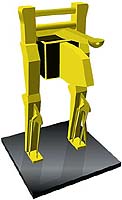| . |  |
. |
|
by Mark Schrope  San Francisco - November 17, 1999 - Influenced by the robotic "exoskeleton" worn by Sigourney Weaver in the 1986 movie Aliens, engineers in Australia are building a two-legged industrial robot that will be able go places and do things no forklift truck ever could.
San Francisco - November 17, 1999 - Influenced by the robotic "exoskeleton" worn by Sigourney Weaver in the 1986 movie Aliens, engineers in Australia are building a two-legged industrial robot that will be able go places and do things no forklift truck ever could.Many robotics groups around the globe are trying to make androids, but a robot biped for industry is a new twist. "Everybody loves the idea of a droid," says project leader Joe Cronin of the University of New South Wales in Sydney. "But we think our robot has a better chance of being commercially viable. The great difference is that humanoids will one day do what humans can do. But our industrial bipeds will be able to do what humans can't do," added Cronin. The Robolift stands 3 metres tall and will be able to lift a load of 500 kilograms when it is fitted with arms. Its power comes from a propane-fuelled 20 horsepower engine--the team decided against weak, quickly depleted batteries. At a symposium on Computational Intelligence in Robotics in Monterey, California, last week, Cronin described how Robolift balanced successfully in their tests, a critical milestone before taking its first steps. Robolift balances much like a person, using a combination of standard movements of its leg and foot joints as well as more drastic hip movements, if necessary. When standing still, the robot should have equal pressure on each foot. If the robot is pushed, sensors in the legs and feet detect it and move the joints to compensate, if possible. If not, then a larger movement is triggered at the hips, just like a person trying to balance on one foot. A gyroscope tells the robot when it has moved enough to stop falling. Once it has arms it will use a similar technique to balance while lifting: a payload will trigger the same response as a push on the robot's back. Ultimately, the robot will be controlled by an on-board operator, but for now a tethered joystick is used. Either way, a built-in computer translates the operator's commands into the movements needed at each joint. If a joint cannot move because of a change in terrain, say, it tells the computer, and the robot makes a drastic hip movement to regain control before it tries to take a step. According to Cronin, balancing was the greatest hurdle in Robolift's development. "We'll have it walking by the end of the year," he says. After that the final step will be to add arms, either like those on a forklift or some type of grasper reminiscent of the machine in Aliens, he says. Robert Howe, an engineer who works with two-legged robots at Harvard University in Massachusetts, is enthusiastic about the Australians' work. "I'd wager they're going to get it walking," he says. "It's an original idea." This article will appear in the November 20 issue of New Scientist New Scientist. Copyright 1999 - All rights reserved. The material on this page is provided by New Scientist and may not be published, broadcast, rewritten or redistributed without written authorization from New Scientist.
ROBOSPACE
|
| |||||||||
| The content herein, unless otherwise known to be public domain, are Copyright 1995-2016 - Space Media Network. All websites are published in Australia and are solely subject to Australian law and governed by Fair Use principals for news reporting and research purposes. AFP, UPI and IANS news wire stories are copyright Agence France-Presse, United Press International and Indo-Asia News Service. ESA news reports are copyright European Space Agency. All NASA sourced material is public domain. Additional copyrights may apply in whole or part to other bona fide parties. Advertising does not imply endorsement, agreement or approval of any opinions, statements or information provided by Space Media Network on any Web page published or hosted by Space Media Network. Privacy Statement All images and articles appearing on Space Media Network have been edited or digitally altered in some way. Any requests to remove copyright material will be acted upon in a timely and appropriate manner. Any attempt to extort money from Space Media Network will be ignored and reported to Australian Law Enforcement Agencies as a potential case of financial fraud involving the use of a telephonic carriage device or postal service. |